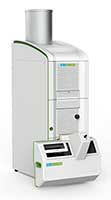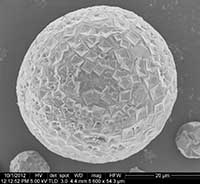Innovative Showstoppers
Four Food Expo Innovation Award winners showcase egg replacement, sensory technology, rapid adulteration analysis, and salt reduction.
If you walked the Food Expo floor at the 2013 IFT Annual Meeting & Food Expo®, chances are you came across some interesting things at various exhibitors’ booths. But four things really stood out and were true showstoppers, according to the Food Expo Innovation Awards competition.
For the 2013 Food Expo Innovation Awards program, a panel of nine jurors from industry, academia, and government with broad expertise in research & product development, processing & packaging technology, and food safety reviewed 60 qualified entries and selected four companies and their innovations for a Food Expo Innovation Award.
IFT President-Elect Janet Collins and President-Elect designate Mary Ellen Camire announced and presented four companies with the 2013 IFT Food Expo Innovation Awards at the opening general session. The winners are Glanbia Nutritionals, NIZO food research, PerkinElmer, and Tate & Lyle.
“The Food Expo Innovation Awards are a showcase for amazing advancements made in our profession,” said Collins. “Exclusive to companies exhibiting at the IFT Food Expo, these awards honor outstanding innovation in products, ingredients, technologies, instrumentation, equipment, and services that were commercially introduced since January 1st of 2012.”
Only companies exhibiting at the 2013 IFT Food Expo in Chicago were eligible. Judging criteria included degree of innovation, technical advancement, benefits to food manufacturers and consumers, and scientific merit.
 Glanbia Nutritionals (www.glanbianutritionals.com) garnered the 2013 IFT Food Expo Innovation Award for its Optisol 3000 egg replacement system, which is comprised of whey protein concentrate (WPC) and milled flaxseed. The WPC contains a unique protein profile to provide additional functional benefits, while the flaxseed component was developed to maximize the gum and fiber contributions from the flax. It can be used as a 100% egg replacer in baked products such as muffins, cookies, and cornbread. Sensory trials have shown no significant difference in appearance, taste, and texture. The product, which adds fiber and contributes significantly less fat and cholesterol than eggs, is a dry powder for ease of handling and extended storage.
Glanbia Nutritionals (www.glanbianutritionals.com) garnered the 2013 IFT Food Expo Innovation Award for its Optisol 3000 egg replacement system, which is comprised of whey protein concentrate (WPC) and milled flaxseed. The WPC contains a unique protein profile to provide additional functional benefits, while the flaxseed component was developed to maximize the gum and fiber contributions from the flax. It can be used as a 100% egg replacer in baked products such as muffins, cookies, and cornbread. Sensory trials have shown no significant difference in appearance, taste, and texture. The product, which adds fiber and contributes significantly less fat and cholesterol than eggs, is a dry powder for ease of handling and extended storage.
“Egg allergen issues could be addressed in some baked products; novel approach with flax seed,” noted a juror.
 NIZO food research (www.nizo.com) won the award for its new sensory technology, acoustic tribology. The technology records and analyzes the sound of rubbing of the tongue against the food, and can be used to predict the sensory effects of food innovations. Creaminess or astringency of new foods or prototypes can now be determined by measuring the sound generated by the food interacting with the tongue during consumption. Acoustic tribology has been demonstrated in a range of dairy systems. It can, however, be applied to any food. The technology is non-invasive, measures in real-time, and can be applied directly on human subjects without any preconditioning or preparation of the body surfaces.
NIZO food research (www.nizo.com) won the award for its new sensory technology, acoustic tribology. The technology records and analyzes the sound of rubbing of the tongue against the food, and can be used to predict the sensory effects of food innovations. Creaminess or astringency of new foods or prototypes can now be determined by measuring the sound generated by the food interacting with the tongue during consumption. Acoustic tribology has been demonstrated in a range of dairy systems. It can, however, be applied to any food. The technology is non-invasive, measures in real-time, and can be applied directly on human subjects without any preconditioning or preparation of the body surfaces.
“An innovative manner in which to measure rheology with intriguing R&D applications,” observed a juror. Another juror declared, “A new tool for evaluating food quality. It can provide considerable sensory insight for product evaluation/quality.” “A novel sensory/analytical method which could help in reducing fat, increasing fiber,” stated a juror.
 PerkinElmer (www.perkinelmer.com) was honored for its AxION DSA/TOF mass spectrometry system, which eliminates time-consuming sample preparation steps and front-end gas or liquid chromatography. This technology allows for the direct analysis of food samples in a few seconds. It can be used for rapid measurement of food adulteration, contamination, and characterization with minimal sample preparation and no chromatography. Examples of food characterization with DSA/TOF include caffeine in beverages, capsaicin in peppers and hot sauces, vanillin in vanilla extracts, and curcumins in turmeric powder.
PerkinElmer (www.perkinelmer.com) was honored for its AxION DSA/TOF mass spectrometry system, which eliminates time-consuming sample preparation steps and front-end gas or liquid chromatography. This technology allows for the direct analysis of food samples in a few seconds. It can be used for rapid measurement of food adulteration, contamination, and characterization with minimal sample preparation and no chromatography. Examples of food characterization with DSA/TOF include caffeine in beverages, capsaicin in peppers and hot sauces, vanillin in vanilla extracts, and curcumins in turmeric powder.
“DSA/TOF is a fast and simple analysis system with significantly reduced sample preparation and analysis time, while providing reliable results. It is environmentally-friendly and uses less solvents and other chemicals compared to conventional chromatography methods,” stated a juror. “Effective measurements of adulteration, contamination, and characterization by DSA/TOF system have been demonstrated in a wide range of food products.”
 Tate & Lyle (www.tateandlyle.com) captured the 2013 IFT Food Expo Innovation Award for its SODA-LO salt microspheres, which can reduce salt content by 25–50% in a variety of foods without sacrificing taste. The ingredient is created with patent-pending technology that turns standard salt crystals into free-flowing hollow crystalline microspheres. These smaller, lower-density crystals efficiently deliver salty taste by maximizing surface area relative to volume. Successful applications to date include bread, peanuts, microwave popcorn, crackers, chips, French fries, and seasoned meat.
Tate & Lyle (www.tateandlyle.com) captured the 2013 IFT Food Expo Innovation Award for its SODA-LO salt microspheres, which can reduce salt content by 25–50% in a variety of foods without sacrificing taste. The ingredient is created with patent-pending technology that turns standard salt crystals into free-flowing hollow crystalline microspheres. These smaller, lower-density crystals efficiently deliver salty taste by maximizing surface area relative to volume. Successful applications to date include bread, peanuts, microwave popcorn, crackers, chips, French fries, and seasoned meat.
“The microsphere concept offers a way to maintain the flavor and functionality of sodium chloride and reduce the sodium ion available,” noted a juror. Another juror remarked, “Reduces salt by up to 50%; still can be labeled as salt; high practical use; simplified technology using size/bioavailability attributes instead of substitutes.”
 Bob Swientek is Editor in Chief, Food Technology ([email protected]).
Bob Swientek is Editor in Chief, Food Technology ([email protected]).
